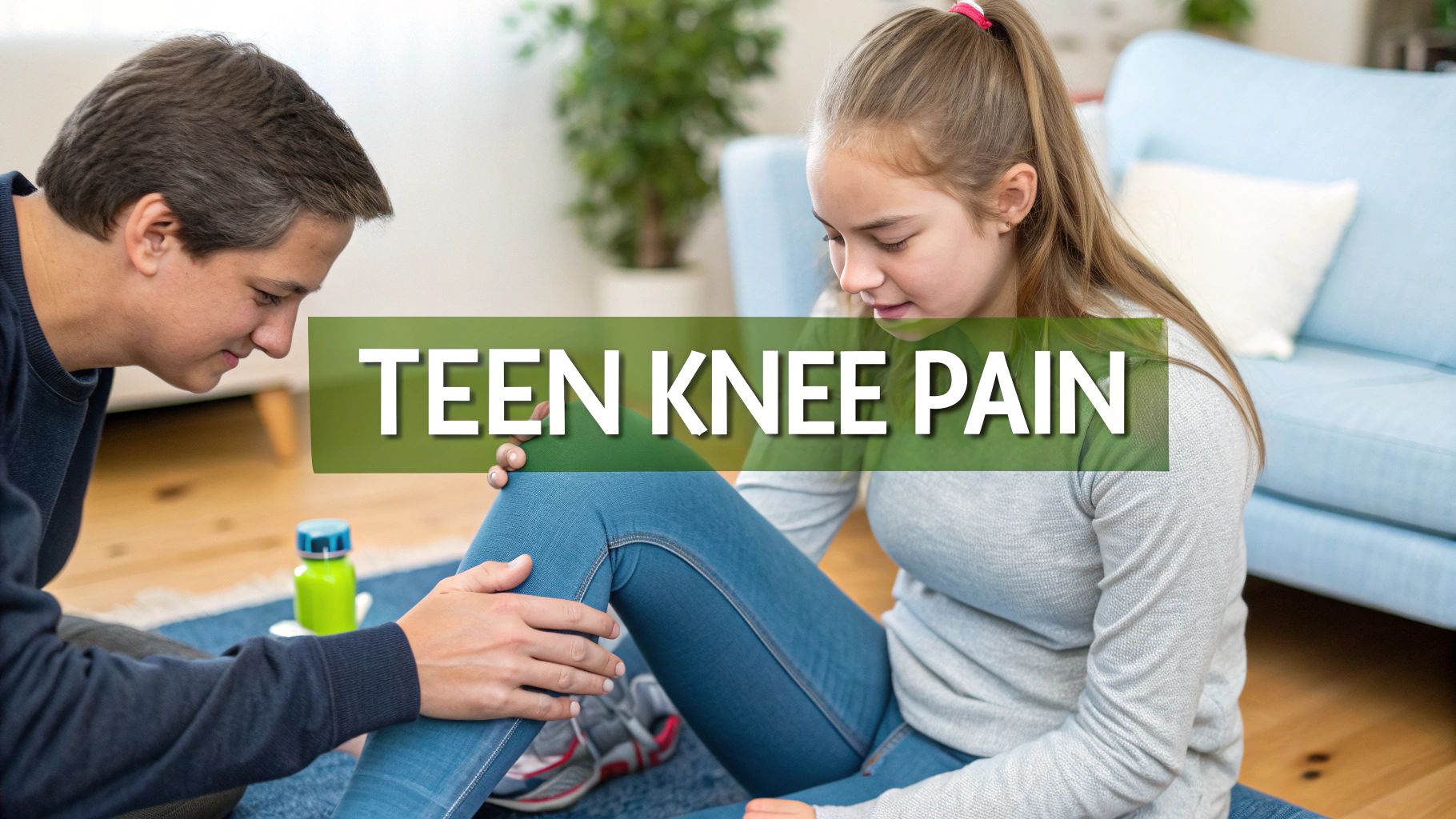.webp)
When your teenager complains about a sore knee, it’s easy to feel a pang of worry. But in most cases, this kind of discomfort is an incredibly common—and usually temporary—part of growing up. It's often linked to the whirlwind of changes happening during adolescence, from sudden growth spurts to a ramped-up sports schedule.
Think of it less as a sign of serious injury and more as a 'growing pain' in the truest sense. The issue is typically down to overuse or specific growth-related conditions like Osgood-Schlatter disease, not a deeper underlying problem. With the right approach, involving a bit of rest, smart activity changes, and targeted exercises, most teens get back on their feet without any drama.
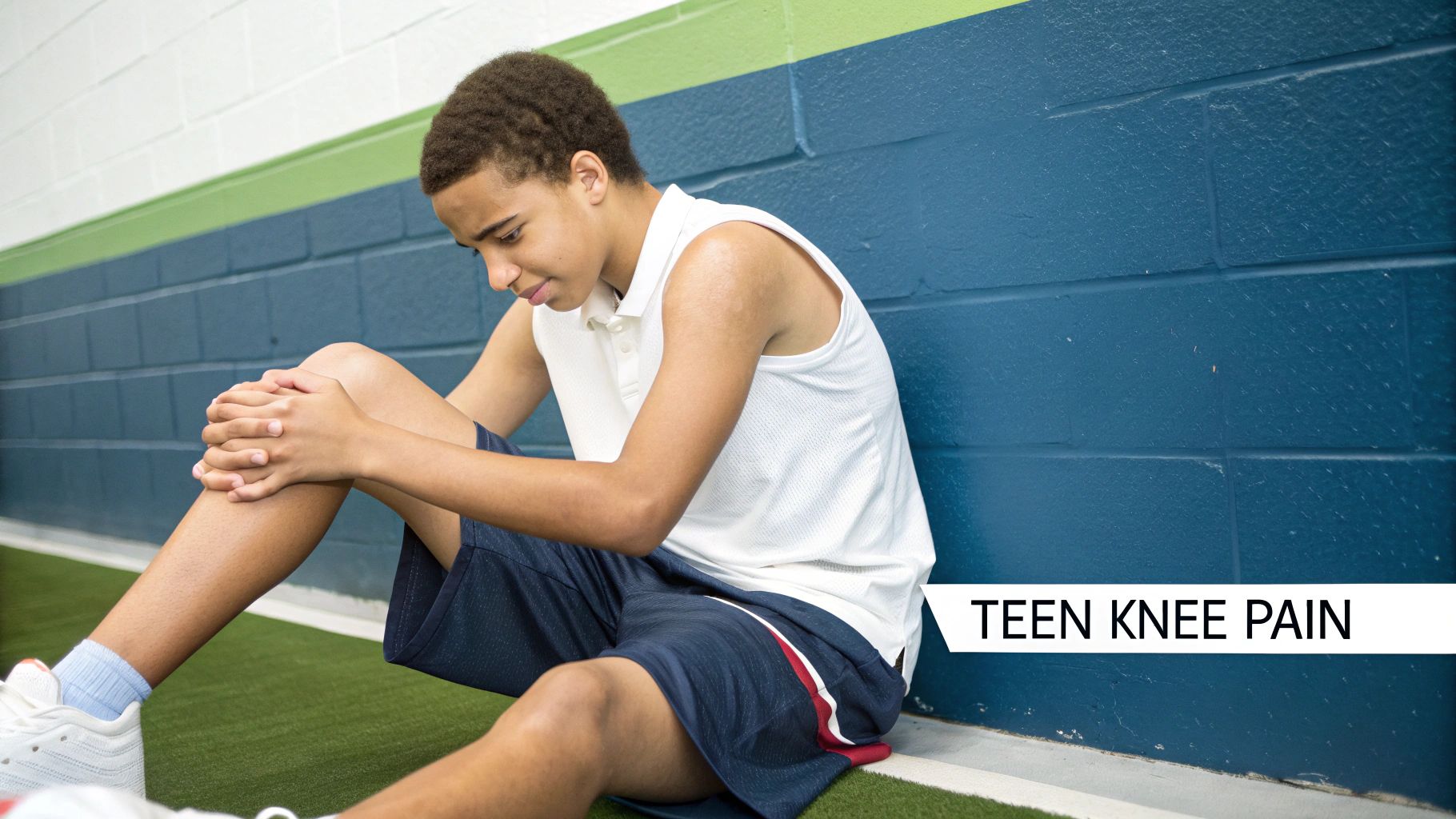
The teenage years create something of a perfect storm for joint pain. It’s a period where biology and lifestyle collide, and the knees are often caught right in the middle. Understanding what’s going on under the surface is the first step to managing the pain and building stronger, more resilient knees for the long haul.
A teenager’s body is a bit like a construction site operating at double speed. The long bones in the legs can shoot up so fast that the surrounding muscles, tendons, and ligaments are left playing catch-up. This mismatch puts a huge amount of mechanical stress on the knee joint, which has to coordinate all this new growth.
During a major growth spurt, the soft growth plates located near the ends of bones are especially vulnerable. When powerful thigh muscles repeatedly tug on these still-developing areas—like the bony lump just below the kneecap (the tibial tuberosity)—it can easily lead to inflammation and pain.
This biological reality is often amplified by a few classic teenage factors:
To put this into perspective, a UK-based study found that 7.4% of adolescents between 11 and 15 reported anterior knee pain. The number climbed even higher for 14-year-olds, hitting 10%—pinpointing just how common this becomes during those peak growth years.
Here's a quick look at some of the most frequent culprits behind teenage knee pain. This table breaks down what they are, what they feel like, and who's most likely to be affected.
Recognising these patterns is the key to getting on the right track. Thankfully, the vast majority of these conditions resolve with time and proper management. For persistent or worrying symptoms, guidance from our specialised paediatric services can provide the clarity and support needed to navigate this phase and ensure a full return to activity without any long-term issues.
Trying to get to the bottom of a teenager's knee pain can feel a bit like solving a mystery. But more often than not, the culprit is one of a few common issues tied directly to their rapid growth, intense activity levels, and the unique physical demands of being a teen. Once you can pinpoint the likely cause, you're already on the right track to managing it effectively.
This visual guide neatly summarises the main reasons for knee pain in adolescents, highlighting how growth spurts, overuse injuries, and sudden accidents are the primary triggers.
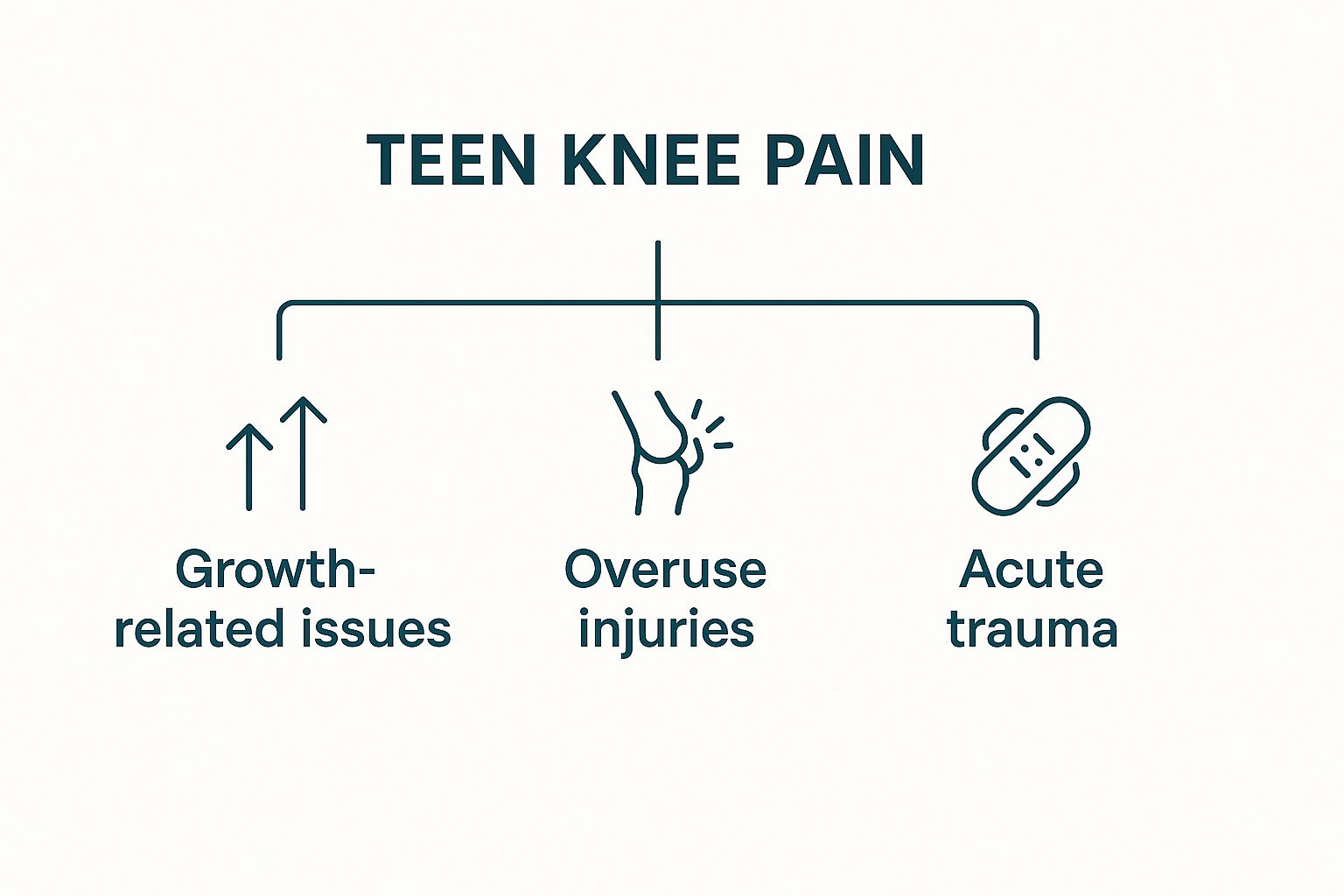
As you can see, while a sudden fall can definitely cause an injury, it’s often the repetitive strain from sports and the biological stress of growing so quickly that are the more frequent sources of discomfort.
One of the most common complaints we hear about is Patellofemoral Pain Syndrome (PFP), which most people know as "runner's knee."
Imagine the kneecap (patella) is a train, and the groove it sits in on the thighbone (femur) is the track. In a perfectly functioning knee, that train glides smoothly up and down the track whenever the leg bends or straightens.
With PFP, the train has come slightly off its rails. This usually happens because of muscle imbalances—think weak hip and glute muscles or overly tight hamstrings—which pull the kneecap slightly off-centre. As a result, it grates against the sides of the track, causing irritation, inflammation, and that familiar dull, aching pain felt around or just behind the kneecap.
This pain typically flares up when:
PFP is incredibly common. In the UK, it’s estimated that the annual prevalence of patellofemoral pain is around 28.9% among adolescents. While the general figure is about 7.2%, this number skyrockets to 22.7% for female adolescent athletes, showing just how much activity levels and body mechanics play a role.
If your teen is complaining of a painful, bony lump just below their kneecap, you're almost certainly dealing with Osgood-Schlatter disease. Despite the name, it isn't really a "disease" at all. It's a classic overuse injury that appears during growth spurts.
Think of it like a game of tug-of-war happening inside the knee. The powerful quadriceps muscle at the front of the thigh is constantly pulling on the patellar tendon. This tendon attaches to a spot on the shinbone (the tibial tuberosity) which, in a growing teen, is still a soft plate of cartilage, not solid bone.
During sports involving lots of running and jumping, the quad muscle yanks on this developing growth plate over and over again. The body’s response is to lay down more bone to protect it, which creates that tender bump. The pain is a direct result of this inflammation and is usually worst during and after physical activity. It's a very common type of musculoskeletal pain in young people, and understanding its mechanical cause is the key to managing it.
Sinding-Larsen-Johansson (SLJ) syndrome is a very close cousin of Osgood-Schlatter. It’s caused by the exact same tug-of-war mechanism, but the stress happens in a different place. Instead of affecting the shinbone, SLJ creates pain and inflammation at the very bottom tip of the kneecap itself, where the patellar tendon begins.
This condition tends to affect slightly younger teens, often between 10 and 14 years old, and is also triggered by high-impact sports like football, basketball, and gymnastics.
Key Takeaway: Both Osgood-Schlatter and SLJ are what we call "self-limiting" conditions. This means they are tied directly to the growth process and almost always go away completely once your teen stops growing and their skeleton matures. Treatment is all about managing the symptoms, not "curing" a disease.
Finally, we have patellar tendonitis, better known as "jumper's knee." This is another common overuse injury. If you picture the patellar tendon as a thick rope connecting the kneecap to the shinbone, tendonitis is what happens when that rope starts to fray from being overworked.
The damage comes from the repetitive stress of jumping, landing, and quick changes of direction. Tiny micro-tears develop in the tendon and don’t get enough time to heal between training sessions, leading to inflammation and a sharp pain, usually felt right below the kneecap.
Unlike growth plate issues, tendonitis can affect athletes of any age. However, it’s particularly prevalent in teens who specialise in sports like volleyball, netball, or high jump. The pain often feels sharpest at the start of an activity, might fade during play, but then comes back with a vengeance afterwards. Recognising these distinct patterns can help you communicate symptoms clearly to a healthcare professional and get started on the right path to recovery.
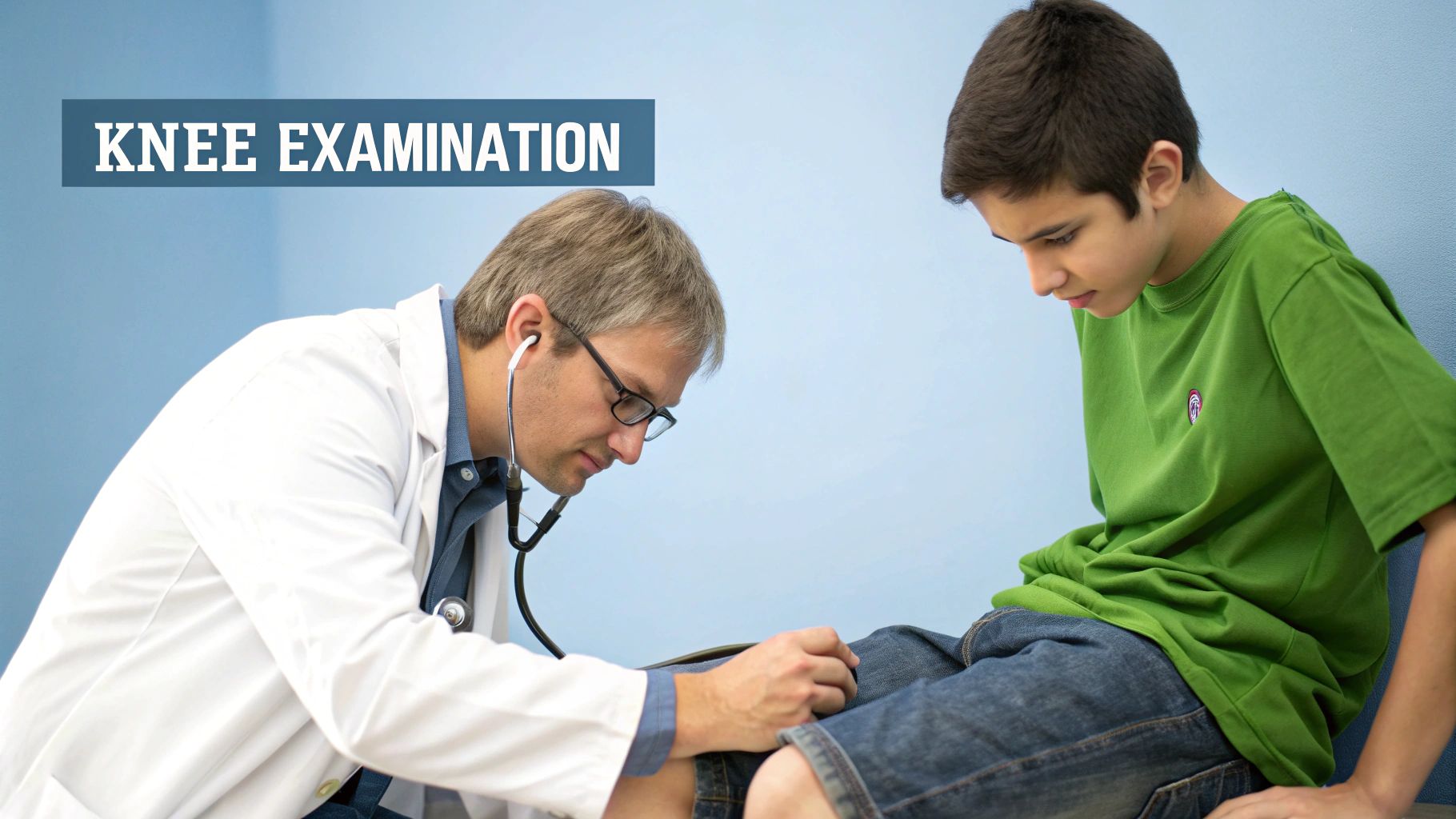
It can be tricky to tell the difference between a minor ache that just needs a bit of rest and something more serious brewing under the surface. Most of the time, teenage knee pain is down to growth spurts and overuse, but knowing when to get a professional opinion is key to a fast, safe recovery.
Trust your gut. As a parent, if you feel something isn't right, getting it checked out is always the smart move. That said, some symptoms are clear signals that it's time to go beyond home remedies and book in with a GP or physiotherapist.
While a bit of pain after a football match is common, some signs point to a problem that needs a proper diagnosis. Think of these as the knee's way of saying it needs more than just an ice pack and a day on the sofa.
You should seek medical advice quickly if your teen experiences any of these:
If the pain comes from a sudden, acute injury, it's vital to choose the right place for immediate care. For urgent but non-life-threatening injuries, knowing the difference between urgent care and A&E is crucial. You can learn more about deciding between an emergency room vs urgent care in our detailed guide.
Heading to see a GP or physio can feel a bit daunting, but knowing what's coming can ease any anxiety for both you and your teen. The first appointment is all about getting a clear picture of what's causing the pain.
The clinician will start by asking a series of questions to build a history of the problem. This chat is a vital part of the diagnostic process, so coming prepared with answers makes the whole thing much more productive.
After taking a full history, the clinician will carry out a physical examination of the knee. This is a hands-on assessment to check for specific signs and pinpoint the source of the pain.
Here's what this usually involves:
In most cases, a good history and a thorough physical exam are all that's needed to diagnose common teenage knee conditions. Further imaging like an X-ray is rarely needed unless a fracture or another structural problem is suspected. Getting that accurate diagnosis is the first and most important step toward an effective recovery plan that gets your teen back in the game safely.
When your teenager is complaining about a sore knee, your first instinct is to help them manage it at home. While getting a proper diagnosis is always the end goal, there are some really effective things you can do right away to ease their discomfort and kick-start the healing process.
For years, the standard advice was simple: rest up and take some anti-inflammatory pills. But we now know that a smarter, more active approach gets much better results. The modern way is all about creating the perfect environment for the body's tissues to repair themselves, without letting everything else seize up.
The old R.I.C.E. (Rest, Ice, Compression, Elevation) method has been updated. The new gold standard for acute soft-tissue injuries follows two brilliant acronyms that work in sequence: P.E.A.C.E. for the first few days, followed by L.O.V.E. to see them through the rest of recovery.
Once those first few sensitive days are over, the focus shifts from damage control to actively promoting a high-quality repair job. That’s where L.O.V.E. comes in.
The days of prescribing a week of complete rest are long gone. In fact, doing nothing can be counterproductive. Muscles around the knee weaken, the joint stiffens, and the whole recovery process just takes longer.
The goal is active recovery. It’s about finding that sweet spot between resting the injury and keeping the rest of the body moving.
Think of it this way: if a single machine on a factory assembly line breaks, you don't shut the whole factory down. You work around it while it gets fixed. A sore knee is no different.
If running hurts, switch to the pool. If squats are a no-go, find exercises that strengthen the same muscles without that specific movement. This approach maintains fitness, keeps morale high, and actively supports the healing process.
Strong muscles are the knee's best friends. They act as natural shock absorbers and stabilisers for the joint. By focusing on the key support team—the quads, hamstrings, and glutes—you can take a huge amount of pressure off the knee itself and fix imbalances that might have caused the pain in the first place.
Here are a few simple, safe exercises to get started with:
Quad Sets (Static Quadriceps Contractions): Lie on the floor with the sore leg out straight. Pop a small, rolled-up towel under the knee. Gently push the back of the knee down into the towel, tightening the big muscle on the front of the thigh. Hold for 5 seconds, then relax. Aim for 2 sets of 10 repetitions.
Straight Leg Raises: Lie on your back with the good leg bent, foot flat on the floor. Keeping the sore leg perfectly straight, slowly lift it about six inches off the floor. Hold for 3-5 seconds, then slowly lower it back down. Complete 2 sets of 10 repetitions.
Glute Bridges: Lie on your back with both knees bent and feet flat on the floor, about hip-width apart. Squeeze your bum muscles and lift your hips until your body forms a straight line from your shoulders to your knees. Pause for a second at the top, then lower back down. Aim for 2 sets of 12 repetitions.
These exercises build a solid foundation of strength without putting direct strain on a painful knee joint. Remember, consistency is far more important than intensity. You can learn more about the benefits of exercise and why moving your body matters in our detailed guide.
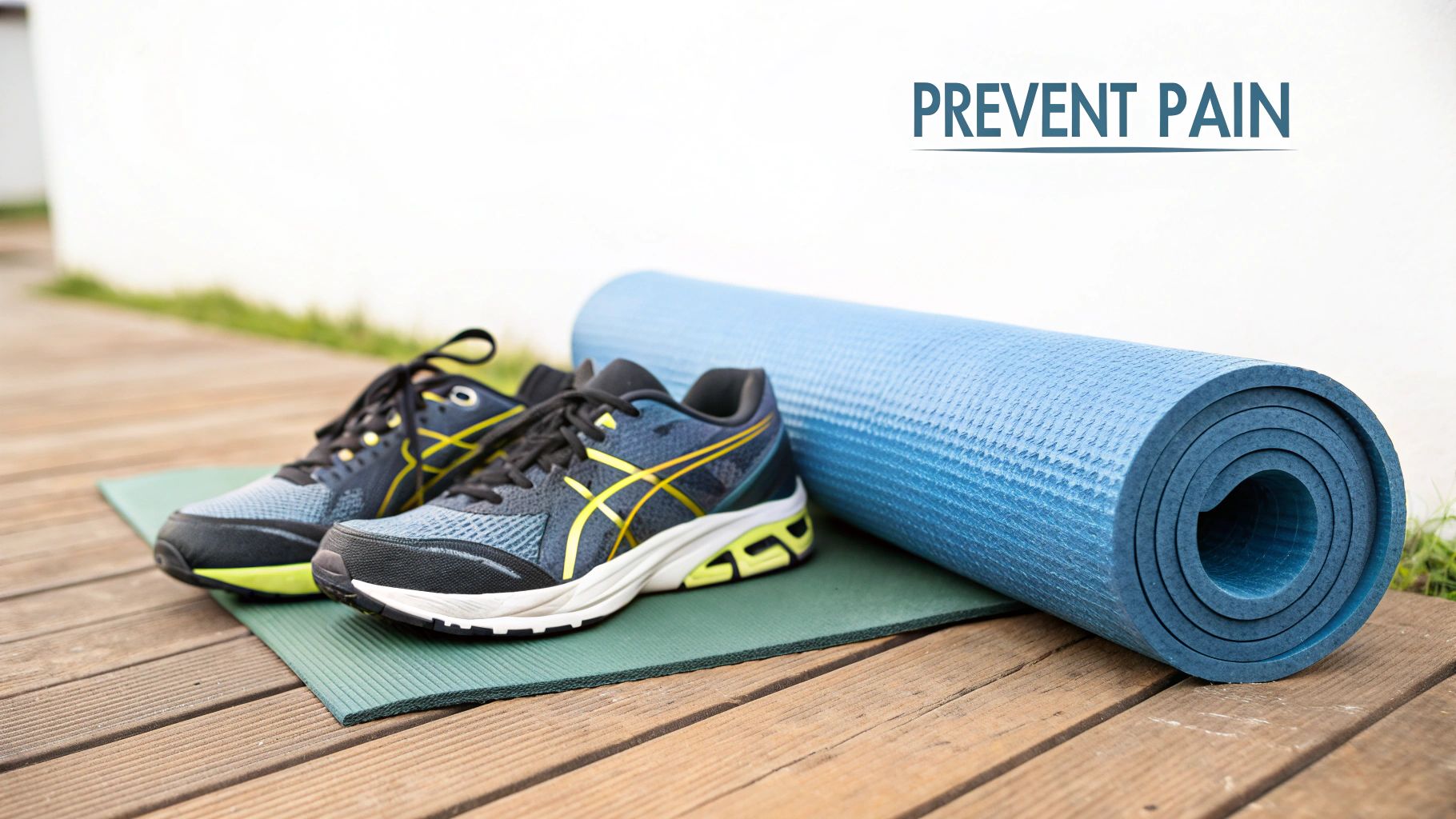
Managing knee pain when it flares up is one thing, but building a foundation for long-term joint health is the real prize. For active teenagers, this means switching from a reactive mindset to a proactive one. By embedding smart habits now, they can build strong, resilient knees that will see them through their sporting careers and well into adulthood.
Think of it like looking after a car. You don’t just fix it when it breaks down; you do the regular maintenance—oil changes, tyre checks—to stop problems from happening in the first place. It’s the exact same principle for your teen's knees, where small, consistent efforts can make a massive difference in preventing future pain.
A proper warm-up and cool-down should be non-negotiable bookends to any physical activity. These aren't just optional extras; they're fundamental to preventing injuries, especially for a teenager already dealing with sore knees.
A good warm-up is like gently waking up the muscles and joints. It gets the blood flowing, raises muscle temperature, and primes the entire system for the demands of sport. This simple prep work makes muscles more pliable and responsive, which massively reduces the risk of strains that can throw the knee out of alignment and cause pain.
Likewise, a cool-down helps the body transition smoothly back to rest. Gentle stretches for the quads, hamstrings, and calves improve flexibility and stop the muscle tightness that so often contributes to conditions like Patellofemoral Pain Syndrome. It’s a vital step for boosting recovery and cutting down on next-day soreness.
In the UK, the prevalence of knee problems among young adults is surprisingly high, hitting 31.8%. Research has pointed to high levels of physical activity as a major risk factor, which tells us that while sport is fantastic, it has to be balanced with smart conditioning and recovery to avoid doing more harm than good. You can read the full study about these lifestyle factors and knee health.
One of the biggest culprits behind overuse injuries is specialising in a single sport too early. When a teenager repeats the exact same movements day in and day out, certain muscles and tendons are put under constant, repetitive stress. It’s a fast track to burnout and injury.
The answer is cross-training. By mixing up different types of activities, teens can build a much more balanced level of fitness without overloading one specific area.
Cross-training ensures different muscle groups get a workout, creating a stronger, more robust support system for the knee joint. This variety doesn't just prevent injury; it keeps training interesting and fun. For tailored advice on balancing activities, our experts in sports and exercise medicine can map out a personalised strategy.
Finally, two of the most effective strategies for long-term knee health have very little to do with exercise itself: footwear and nutrition. The right shoes are the first line of defence, absorbing shock and providing stability. Make sure your teen has sport-specific shoes that are replaced regularly—the cushioning and support wear down long before the outside looks shabby.
Maintaining a healthy weight and a balanced diet is just as important. Excess weight puts significant extra strain on the knee joints, while a diet rich in vitamins and minerals supports healthy muscles and bones. These foundational pieces work together, creating an environment where a teen's knees can thrive for years. For a structured approach to recovery, exploring professional physiotherapy can be incredibly effective for building lasting knee health.
When your teenager is dealing with knee pain, it’s natural to have a lot of questions. Let's cut through the confusion and get straight to the answers for some of the most common concerns we hear from parents and young athletes.
While the term "growing pains" gets thrown around a lot, it’s often misunderstood. True growing pains are usually a dull, muscular ache that affects both legs—not a sharp pain in a specific joint like the knee. They also tend to be most noticeable at night.
If your teenager has persistent pain located in or around the knee, especially during or after activity, it’s almost certainly not just “growing pains.” This type of focused discomfort is a big clue that there’s a specific, treatable condition at play, like Patellofemoral Pain Syndrome or Osgood-Schlatter disease.
A knee brace can feel like a quick fix, and it’s true that it might offer some temporary support and relief. But it’s not a long-term solution. Think of it more like a temporary patch than a proper repair job. Relying on a brace for too long can even weaken the very muscles around the knee that are crucial for stability.
The most important first step is a professional diagnosis. A physiotherapist can pinpoint the root cause of the knee pain teenagers experience and determine if a specific type of support is genuinely helpful as part of a complete recovery plan, which must always include strengthening exercises.
This is the big question for many families, and the answer really depends on the specific diagnosis and how severe the pain is. Pushing through sharp or worsening pain is always a bad idea—it’s a fast track to turning a minor issue into a major one.
That said, the solution is rarely complete rest. More often, what’s needed is "relative rest." This means modifying activities, not stopping them completely. For instance, a physio might suggest swapping a high-impact sport like running for a low-impact alternative such as swimming or cycling. This clever approach allows the knee to heal without your teen losing fitness, getting them back to the sport they love safely and more quickly.
The recovery timeline for knee pain in teens can vary quite a bit. Growth-related issues like Osgood-Schlatter disease often resolve on their own once the growth plates close after puberty, but in the meantime, physiotherapy is brilliant at managing the symptoms.
For overuse injuries, you might see improvement within a few weeks with the right blend of rest, activity changes, and targeted exercises. The single most important factor is getting an accurate diagnosis and then sticking to the recommended treatment plan. Ignoring the problem will almost certainly lead to a longer, more frustrating recovery.
At The Vesey, our team of specialists can provide an accurate diagnosis and create a personalised treatment plan to get your teenager back to their active life, pain-free. Find out more about our expert paediatric and sports medicine services today.

